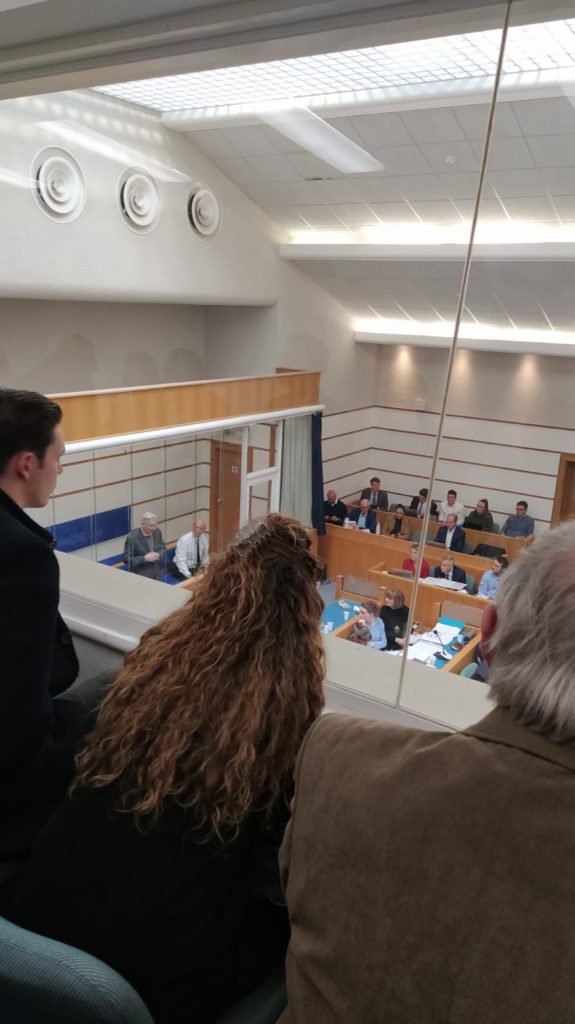
Julian Assange on trial from 24 to 27 February 2020
Monika Karbowska
Introduction: this article was finished just before the current events. Therefore, it does not contain any allusion, except unintentional, to the crisis we are experiencing. I decided to publish it because the repressive system is not suspended: those whose rights are violated need us more than ever. As it is forbidden to take pictures inside the court, I made the drawings to show the place.
For the Wikijustice association, since its creation, there is no « unimportant » hearing in contrast with an « important trial ». That’s why we didn’t focus on these days of the end of February announced with great pomp by the media as « the extradition trial of the century ». On the contrary, for the past six months we have been making every effort to be present at all the Westminter Magistrate Court hearings, which was not easy – getting reliable information in time, overcoming obstacles to attend the hearings at 181 Marylbone Avenue. Every brief encounter with Julian Assange, live or on video, was a proof of life for us and an opportunity to testify about his health and situation. After all this hard work since last August, I was relieved to know that he was alive, but I was also happy to know that I would be able to see him for 4 days, to give him our support and sympathy and maybe to communicate with him and transmit a message from him. All our efforts are aimed at his full and complete liberation, we would so much like him to know it and to be ready for this moment which we do not doubt is imminent.
So I was able to attend the trial for 4 days in the courtroom next to Belmarsh prison, in the London suburb of Thamesmead, and I was able to see Julian Assange for 5 to 6 hours each day.
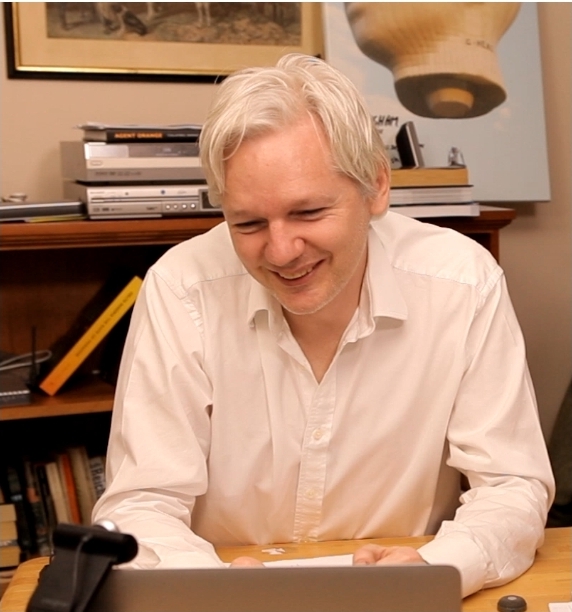
But first I had to get into the premises. I could only take the subway and the bus from the London suburbs at 5:30 am and arrive on site at 6:45 am. Right away I noticed the camping of tents in the small park adjacent to the prison gate and yard. In France, the police would never have allowed activists to camp in front of the walls of a prison. England never ceases to amaze me with its lax system on certain points, tolerating passes, discrimination, violence and encouraging the violation of rules, procedures and rights in other circumstances. Precisely the « first come first served » rule for which we fought so hard at the Westminster court is about to be violated again: There are 14 people in the queue in front of the gate and Greekemmy has already created an illegal list on which she registers people after having duly torn off their names under the threat of not being able to get in despite waiting. Right in front of me are Christophe Deloire, secretary general of Reporters Without Borders, Christian Mihr, his counterpart from the German branch and Rebecca Vincent, head of the RSF office in Great Britain. I protest loudly against the appearance of the list. I know from experience that new people who arrived later will be added to the list and that I will not be able to enter because of this free ride. Greekemmy rushes towards me, raises his voice, threatens me with expulsion from the court. I take Christophe Deloire as a witness, in French. He seems to support Greekemmy’s list while I tell him that he would certainly not tolerate this kind of situation in France, that an ordinary person takes the names of people in the public space and decides who has the right to enter a court, so why does he accept this in the context of Julian Assange’s trial. He doesn’t answer me, but when other people who arrived later pass by us, an American woman living in France, who is standing behind us, also decides not to let herself be taken in. We stayed for an hour discussing the cultural aspects of our adventure while Edward Hamilton Fitzgerald, Gareth Peirce, and many journalists and cameramen arrived and entered the building after presenting a press card to the security guards. However, not all press cards are equal, as Wikijustice members who show theirs are turned away. Police officers, probably municipal ones, also arrive and greet Greekemmy and his relatives with a relaxed look. They just ask a young man behind us to remove his Anonymous mask and point out that there will only be 18 seats for the public.
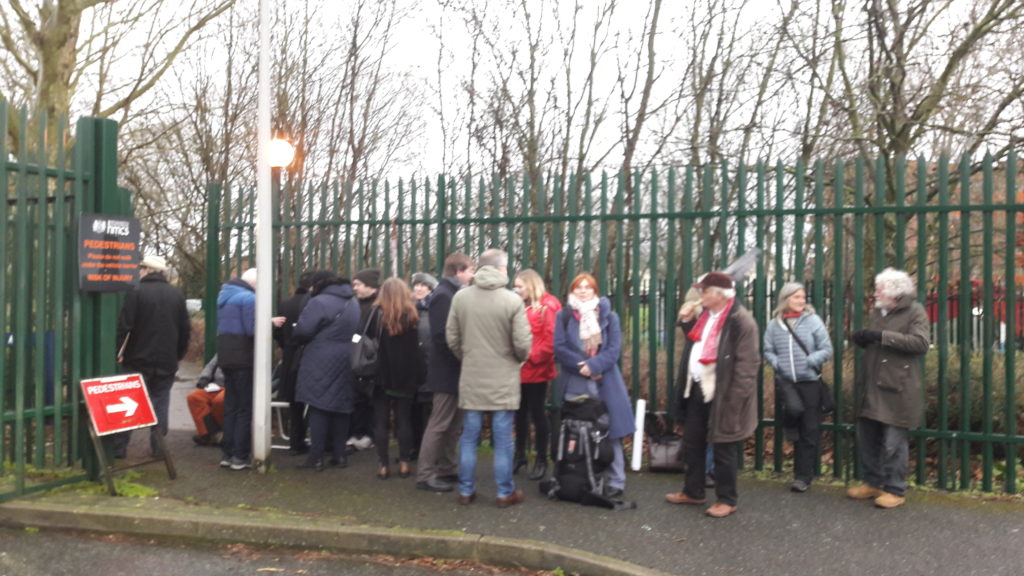
The atmosphere becomes tense, however, when the security guards take us into the garden and park us in front of the building’s door between two rows of security barriers. There are already 30 of us in line as supposed journalists break through our group to get to the front. Journalists also enter easily through the right-hand line delimited by two other security barriers. There will be more than 100 journalists entering and leaving the court at any given time, 26 will have a seat directly in the courtroom. This is the moment that Greekemmy chooses to attack me again with insults while filming me with her cell phone while I protest against her behavior. I see especially that she gives herself for mission to divert the attention of the free ride of a very young girl who arrives from behind and brutally pushes my comrades to put herself in front of us. We protest but when I touch her arm to incite her to stop she starts to shout « don’t touch me » with a cynical arrogance which plunges us into stupor. She is seconded by her companion, the boy in the Anonymous mask, while Greekemmy continues to verbally assault me. The tone and violence rises in the line, the security guards do nothing to defuse the conflict but when I turn to the policemen who are watching us from 1 meter away, so that they bring some order, I am amazed to see that seeing people fighting to enter a court makes them laugh. They seem to be waiting for the strongest to win. Obviously the English system will never stop annoying me. I explain to my companions in misfortune that when one starts by finding normal the rights and violence in a queue in front of the court, one should not be surprised that one ends up getting used to the violations of rights and the defects of procedures by the same court of which Julian Assange is victim since several years.
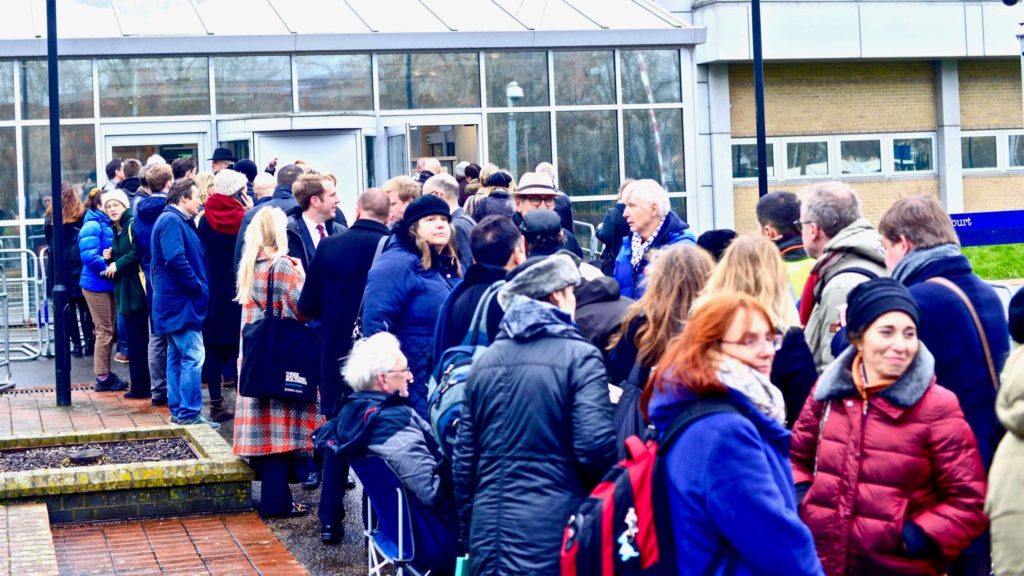
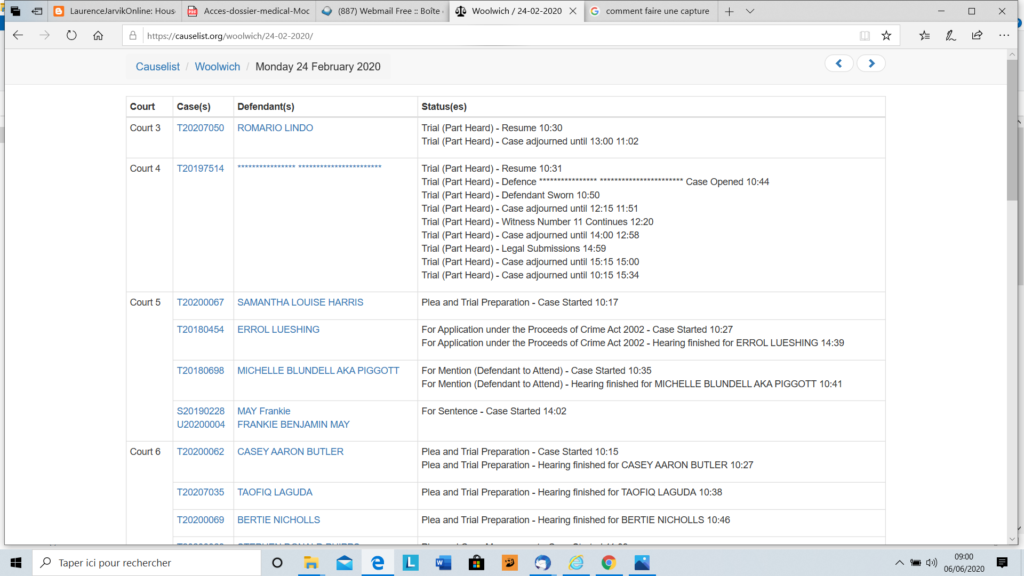
The organization of the court could not be stranger either. The sign hanging over the entrance gate reads « HMCS », « Her Majesty Court Services ». On a metal sign in front of the building before the security gates it says « Woolwich Crown Court », but when I stand in front of the door on the left where the security guards are directing us, I see a simple A4 sheet of paper stuck on it with an arrow to the left and the words « Belmarsh Magistrate Court. On the right door, through which other users enter, a similar sheet of paper reads « Woolwich Crow court ». While the trial of Julian Assange is taking place in the left wing, life goes on in the right wing of the building where the real Woolwich Crown Court works. Moreover, in the left wing of the building we will find almost all the staff we know from the Westminster Magistrate Court. So where are we really? The « Belmarsh Magistrate Court » seems to have only a very formal existence: the website of the British Ministry of Justice gives its address as 1 London Road in Bromley[1], a suburb of South London, while the Law pages gives it as 4 Belmarsh road in Thamesmead[2]. However on the map of Thamesmead 4 Belmarsh Road is not found, the number 2 being the address of the Woolwich Court, that is to say the building in front of which we are, whereas at 1 London Road in Bromley is in fact the Bromley Magistrate Cour[3]t.
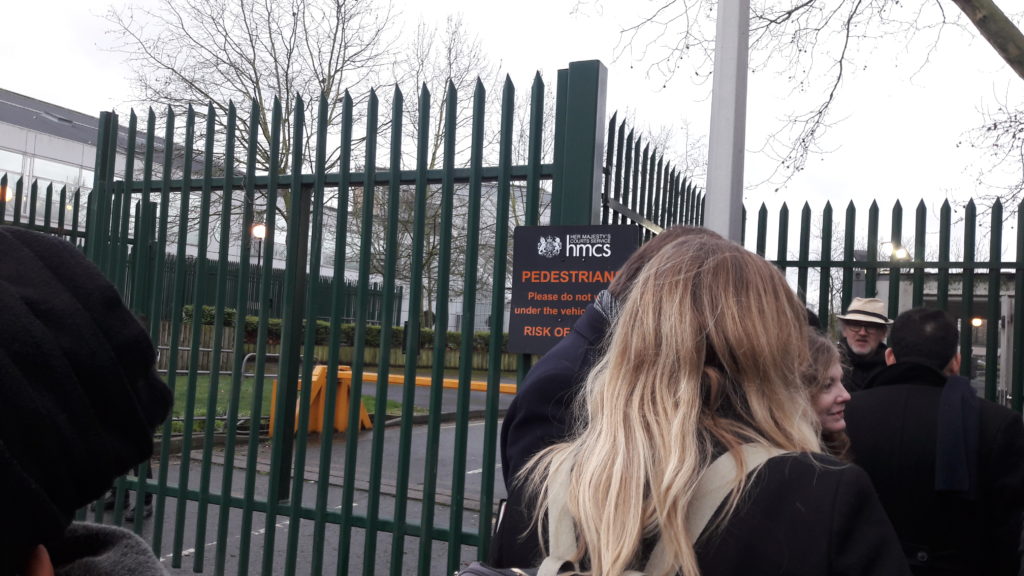
We are exhausted when finally a young security guard, distraught and overwhelmed, unlocks the door and pushes us to prevent the crowd behind us from rushing in. He demands IDs from us and only lets 6 people in at a time. Indeed, when I came the two previous times for information, the Woolwich Crown Court had only one metal detector, obviously sufficient for the rather sparse activity of the institution. Today, another metal detector is installed for the users of the Woolwich Crown Court on the right side of the entrance, while tables are set up on the left side to manage the control of the visitors of Julian Assange’s trial in a rather artisanal way. On the tables are small plastic lockers in which to put the computer, coats and scarves, belts, shoes … it looks very « airport ». In all the overflow, the two young free riders from behind are obviously in front of us. I run as fast as I can to the floor, I get information from two security guards, because the Assange trial is not indicated anywhere, neither on the screen that displays the hearings of the day, nor on the information panel on the left of the hall.
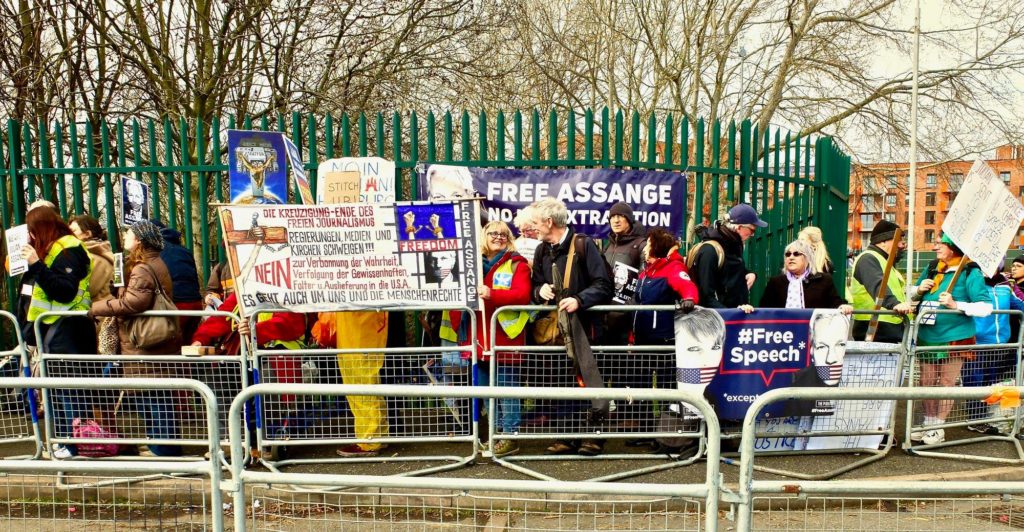
I rush into a corridor, then into a space equipped with armchairs like a waiting room, then into a kind of narrow corridor, I arrive in another antechamber and there I see the door of the courtroom. I enter, and I could have stayed there because nobody asks me anything, but as I am not sure that I have the right to stay, I prefer to look for my comrades and to wait with the public not to lose the precious place. The place where someone told them to wait turns out to be this tiny hallway between two corridors, where we are soon squeezed together in front of a locked door and a small plastic sign marked « public gallery » with an arrow. The violent free-riding continues because there are 25 of us, the security guards have let in far more than the 18 places provided. Worse, when a very small agent tries to coax the crowd, he will have to shout loudly to announce that 6 places must be reserved for the family…
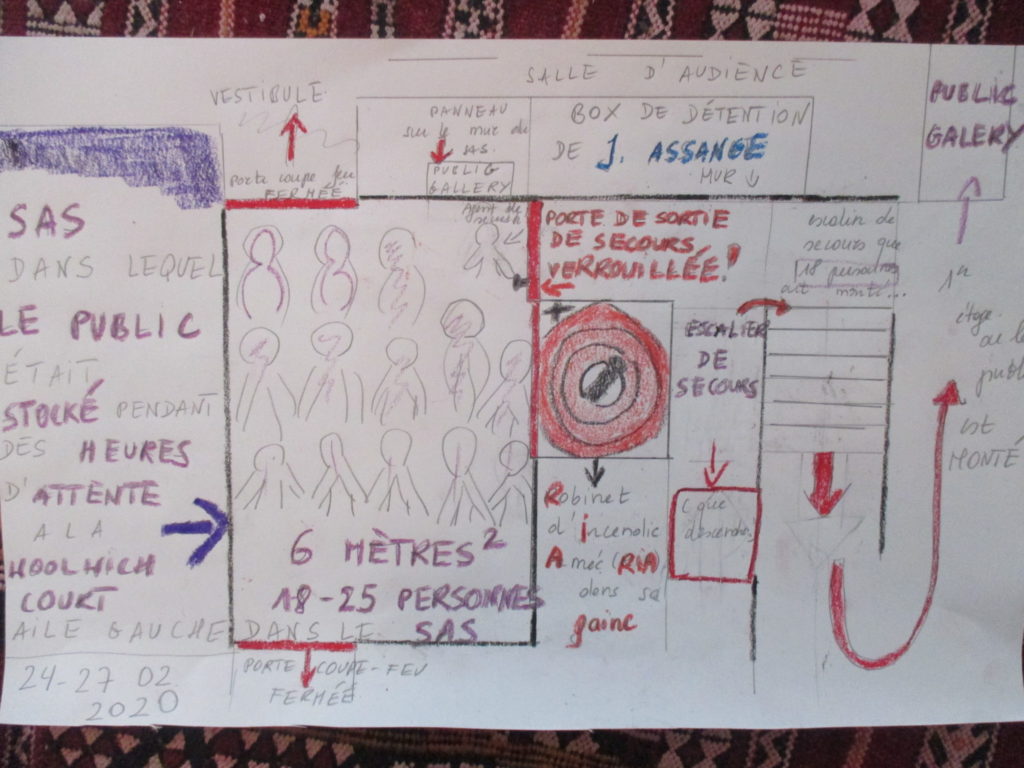
The tension is such that I only notice two days later that the « hose » where we are going to spend a lot of time waiting is in fact an airlock, that the 25 people stored inside prevent the release of the CHC (Common Horizontal Circulation) and their presence blocks the RIA (Armed Fire Faucet) locked in a shaft – this situation violates the fire safety standards commonly accepted, in Great Britain as in France. Worse, I soon noticed that the locked door we were waiting in front of was a… fire exit! An emergency exit leading to a fire escape should never be locked because in case of fire we will not be able to evacuate and we may simply die[4]. Just before 10 o’clock, the security guard unlocks the emergency exit and makes us enter a staircase which is obviously a fire escape. We have to go up this way to get to a landing where we pass a fire door, we find ourselves in an anteroom where there are women’s toilets on the right and men’s toilets on the left, and from where two corridors lead on the right to « courtroom 3 » and on the left to « courtroom 2 ». Ours is Courtroom 2, we have to enter another space where there are two doors that are probably the accesses to the gallery in normal time. Another security guard, a tall, severe redhead, opens a third door and shows us the seats to occupy. Behind a glass window, overlooking the courtroom by at least 10 meters, is the public gallery with 18 seats arranged in two rows. At the back is another locked door.
I don’t have time to think about the strange layout of the place on this first day of the trial: just as the agent opens the emergency exit, a portly Mediterranean man who was in the front of the line with Greekemmy stops me by taking my arm and tells me to leave my seat « to the Courage Foundation » which has just arrived. Stunned, I answer without hesitation « no » and when the man, in a threatening tone, says to me « how dare I refuse my place to the famous Courage Foundation », I answer that I also have the right to be there. Then I run up the stairs without asking for anything else and when I arrive in the gallery, I can only sit in a central place in the second row from where I can only see Julian Assange from a distance. However, the two members of the Courage Corp, a young man with red hair and a beard, perhaps Nathan Fuller, the manager of the New York company as can be verified on the NYS Department of State Division of Corporation website[5], and a 60 year old woman, took their seats just to the left of our group. The woman will take several pictures of Julian without the security guard worrying her. Similarly, the arrogant young woman who pushed everyone this morning took a seat next to her companion, but she slipped out of the room all morning and in the afternoon she took several pictures of Julian. The security guard finally kicked her out after the fourth photo.
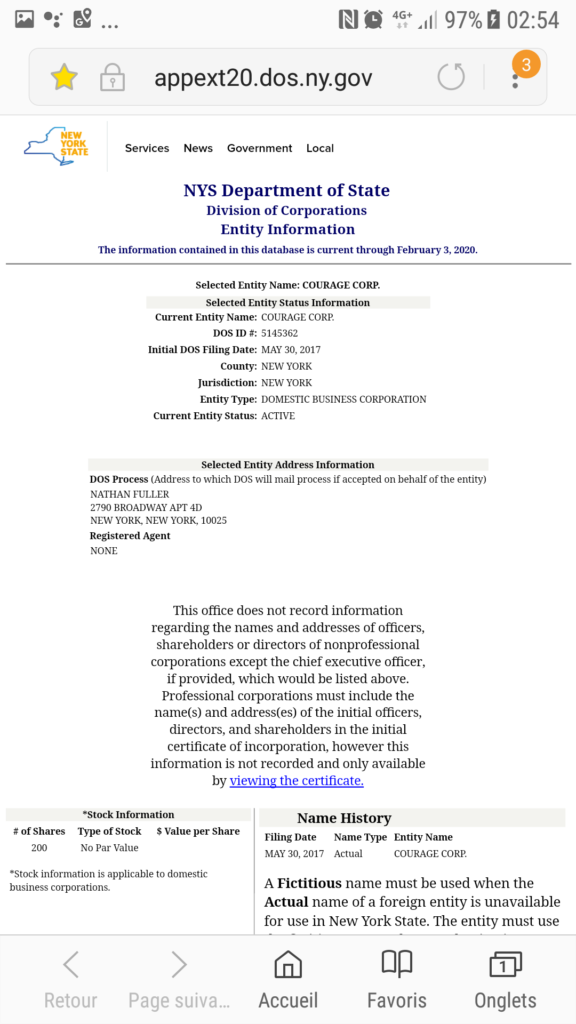
Today I am still surprised that the man who wanted to kick me out of the court was Patrick Henningsen, a journalist from Russia Today International. The declared hostility of this journalist to my person surprises me all the more as I am seeing him for the first time and members of Wikijustice are working without problems with Russia Today, one of the journalists of RT France is going to interview me here later.
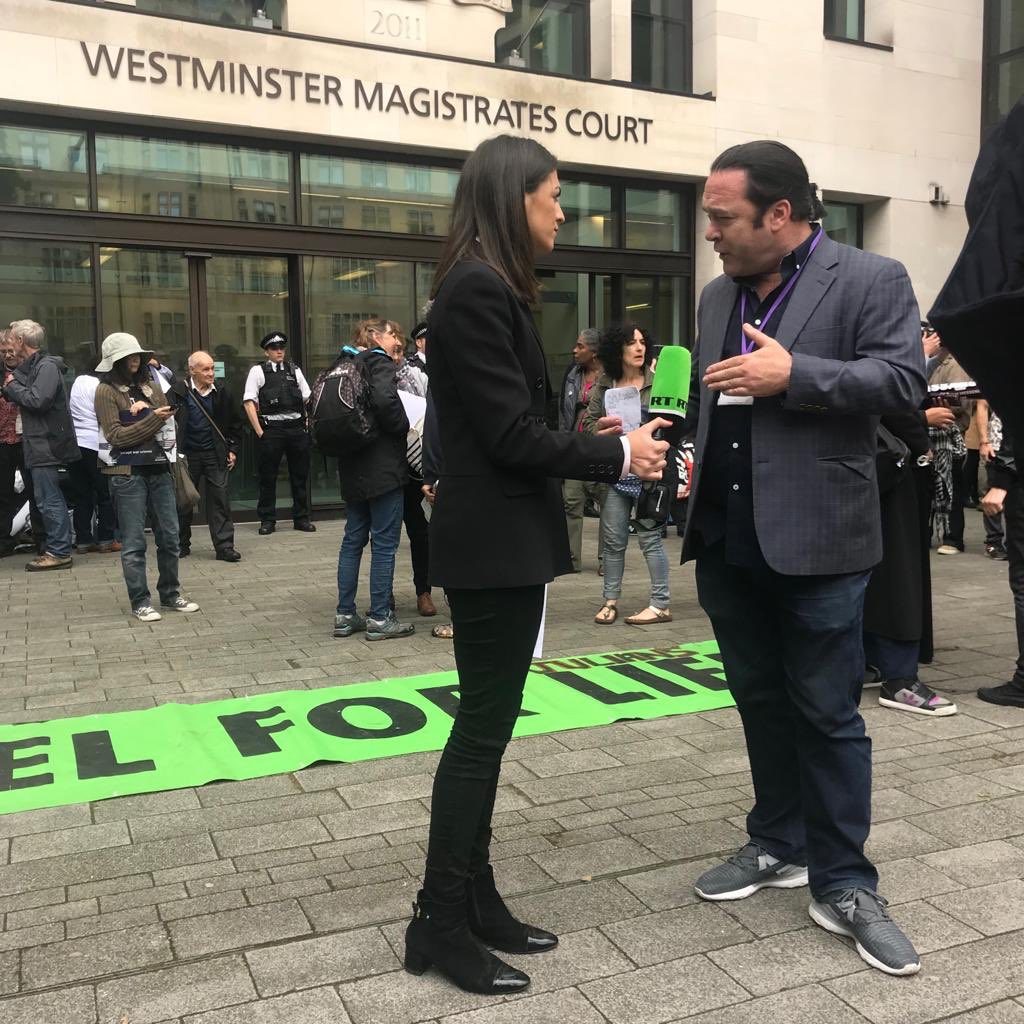
The best seats in the front row are occupied by the representatives of RSF sitting next to Kristinn Hrafnsson and Fidel Narvaez. After the break, the members of the German left-wing party die Linke Sevim Dagdelen and Heike Hänsel will arrive and two young people will give up their seats. Angela Richter, the German theater woman, will be seated in the 5th place in the front row from the left. On the right in the front row we are told that Julian Assange’s family is present: John Shipton, his son Gabriel Shipton, a tall, well-built older man, a 55-year-old woman with long, curly brown hair, and a young, dark-haired man with a pointed nose. I ask around – I hear it’s John Shipton’s brother, the brother’s wife and their son. At the far right Craig Murray is sitting with the family. What struck me was that throughout the hearing none of these people showed any emotion, except maybe a little Murray. Julian did not greet these people who call themselves « his family », he had no sign of collusion with them, no gesture, not even with Shipton. When Julian Assange turned his head toward this part of the gallery, it was as if he were seeing strangers. There were some rather unpleasant « I’m watching a show » aspects to their behavior. Some members of the family could not help but be on their phone despite the formal prohibition stated by the supervisor.
Below, I see the entire staff of the Westminster Court as we have known it since September. I see Rosie Sylvester, the manager, one of the clerks I’ve seen before. I see Prosecutor Lewis but the team of « Americans » and Clair Dobbin are by the gallery balcony as they sit at the far end of their bench on the right, in the front row. On the left side of this bench sit Edward Hamilton Fitzgerald and Mark Summers. Gareth Peirce is sitting behind them with his two assistants and Alistar Lyon. Finally, as a surprise because I did not know that a lawyer from another European bar could participate in a trial in Great Britain (what European directive makes this possible?), I note the presence of Baltazar Garzon in the back row, next to him Jimenez Martinez, Stella Morris and the young Mc McGrath. Jennifer Robinson is sitting with three men on a bench perpendicular to the lawyers, just in front of the rows where the 26 journalists who are lucky enough to have been admitted to the courtroom are seated. The long dock with its bay window is just behind Baltazar Garzon, who will be the only lawyer to greet Julian Assange twice, to shake his hand in the joint of the windows. Similarly, when Julian Assange tries to communicate with Gareth Peirce, he will first pass small handwritten papers to Baltazar Garzon for him to give to the lawyer. The former judge will appear nervous during the reading of the indictment and will leave the room several times. Baraitser will be seated behind a long table on a platform facing the room. Heavy files of documents will be scattered on the desks as the hearings progress, next to stabilizers and computers, documents will fall to the floor, but some lawyers will also spend time on their cell phones, which can be seen very well from above.
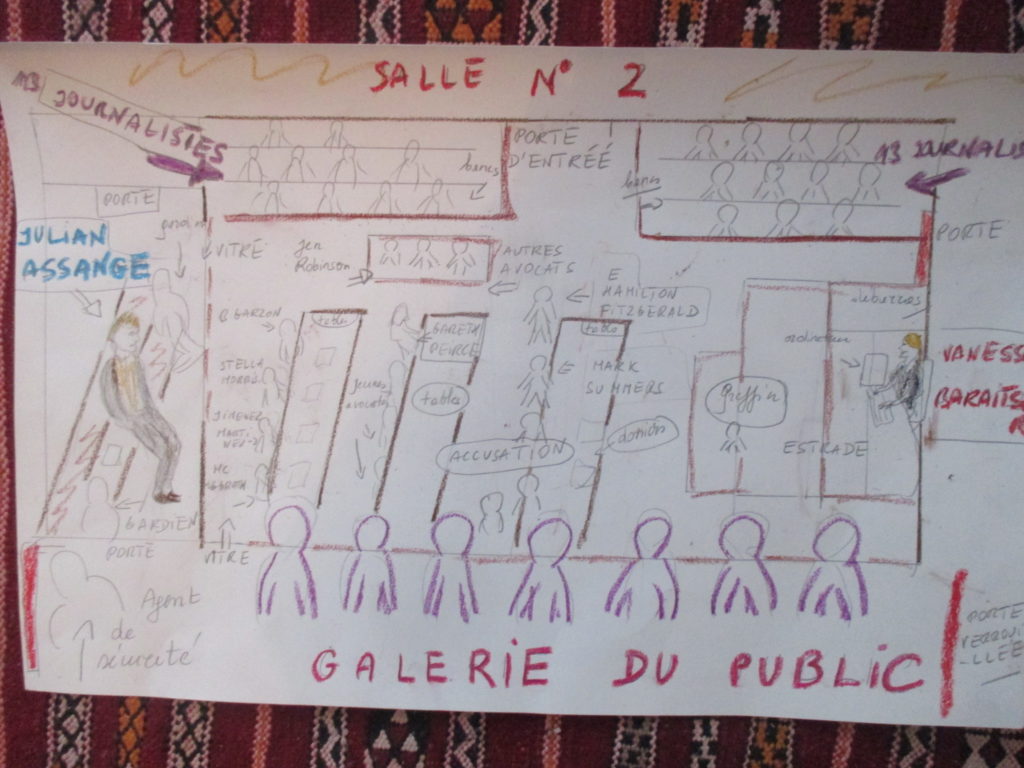
The emotion is palpable when Julian Assange enters through the back door of the box. He is flanked by two guards, a black man in a Mitie uniform (all the security guards present are employees of the Mitie company) and another, a stout white man in a white shirt and black pants. The latter glances suspiciously at the public in the gallery and will be the one to warn his colleague when one of my colleagues ventures to take a picture of Julian Assange. At first glance, he seems to be quite decent with his prisoner. Julian Assange is wearing a gray suit, with a gray sweater and a white shirt. His hair is cut short, he is clean-shaven and wears two pairs of glasses – one on his forehead and the other he will hold in his hand to use when sometimes he consults the huge file he is placing next to him on the bench. As he sits in the middle of the bench, I can see him from my seat. I can see that he has difficulty moving, even sitting still, because he has to hold on to the back of the bench. Also, when he puts his left leg on his right knee, it seems to me that it is to be able to balance the big file on his knees. Most of the time he remains with his hands clasped, fingers crossed, in an attitude of prostration and resignation. I see his sad face, especially when he looks up at the ceiling, the sky he cannot see, in the attitude of one who wants to escape from here at all costs… He blinks while tilting his head back, repeating this tic every 10 minutes or so. When his gaze sweeps the first row of the gallery, I think I detect in his eyes an expression of anger, disgust, a feeling of betrayal perhaps. Sometimes I see in his features something even more negative, a rictus of pain, perhaps hatred, and fear. Then he nervously rubs his fingers together, the same repetitive gestures that we have seen before and that the Wikijustice doctor has duly analyzed as symptoms of suffering due to torture.
The indictment justifying the extradition – the question of legal responsibility
From the outset Baraitser gave the floor to the prosecutor, and we will be watching the presentation of the indictment all morning. It is important to hear it at last, so many rumors have been circulating about it. Nevertheless, it is painful to hear such harsh assertions that seem monstrous to us. Indeed, the prosecutor immediately details the two charges: Julian Assange is accused of « computer misuse » and « conspiracy » with Chelsea Manning in order to steal classified documents, and then of disseminating these same documents with the names of the people involved, which led to the endangerment of these people, collaborators of the American army in Iraq and Afghanistan, who thus risked death or torture. Clearly, computer intrusion and theft in a meeting… it is very disturbing to hear this. Moreover, the prosecutor curiously relies on the « evidence » given by the media: he cites newspaper articles (El Pais, Le Monde, Guardian…) which at the time in 2010 had accused « Wikileaks » of publishing thousands of « unredacted » documents. This part of the indictment can already be understood as a trial of the press, since it relies on the press to provide evidence for an accusation, without the prosecutor however making explicit the exact role of Julian Assange in the structure or organization « Wikileaks ». The link between « Julian Assange, a man physically present here, and « Wikileaks », which the prosecutor does not specify « what it is » (NGO? company? website? according to the laws of which country?), is not proven other than by the prosecutor’s assertions: Julian Assange would be « Wikileaks founders » or « the puppet master ».
For those of us who have known for some time that John Shipton is the owner of the Wikileaks domain names within the Californian company Dynadot[6] and that Julian Assange was only an employee of the Wau Holland Foundation, which piloted the « 04 Wikileaks » project in Germany, It appears that it is not Julian Assange who is legally responsible for the actions of « Wikileaks » but John Shipton and the leaders of the Wau Holland Foundation such as Andy Müller Maguhn, Bernd Fix, Jens Ohlig, Winfried Motzus and Hendrik Fulda[7]. The prosecutor makes the point by quoting points from his documents… 15, 16 and 17, Julian Assange would have nothing less than facilitated the revenge of the Taliban after having hacked computers and stolen state documents in criminal association. He would therefore not be a journalist. Curiously, however, he is only « charged » with the documents published from September 2010 to November 2011. He is not charged for the film « collateral murder » nor for the « Spy files », those famous documents of widespread spying that so upset Chancellor Merkel when she discovered through them that her personal cell phone was listened to by the CIA.
These documents were so important to the leaders of Wau Holland Siftung that three of them traveled to London to prepare the press conference for the launch of these publications on December 1, 2011[1]. The prosecutor ends the tirade by mocking the media writing about the « 175 years in prison ». According to him the case law would show that the sentences for this type of crime only range from 48 to 65 months in prison. But just after we regain hope, he asserts that in this trial, there is no need for evidence, since it is an extradition trial. The evidence will be presented in the United States when Julian Assange is there.
[1] http://www.wauland.de/media/2011_Jahresbericht.pdf, page 5
We feel like we are witnessing the curtain rising on a horror show. Baraitser raises it, we are chased out of the room. Julian Assange looks resigned but nevertheless raises his fist, without looking at the audience. The security guard chases us out of the fire escape and we find ourselves in the airlock, with the whole crowd. I quickly understand that there is no question of taking advantage of our 10-minute break because we will lose our hard-won seat. So I stay in front of the emergency door, trying to reason with my comrades the young free-rider who continues her asocial and disruptive behavior: she pushes us with her elbow, shouts that she is the most important and must remain so, proudly answers that she is 23 years old when we ask her what makes her think that she is entitled to so many privileges. She seems to be under the influence of substances and it is disconcerting to see someone behave like this in a court of law and to witness the total passivity of the officer in charge of order, who even lets her back in front of everyone in the gallery. Privileged, absolutely. Why, we don’t know then.
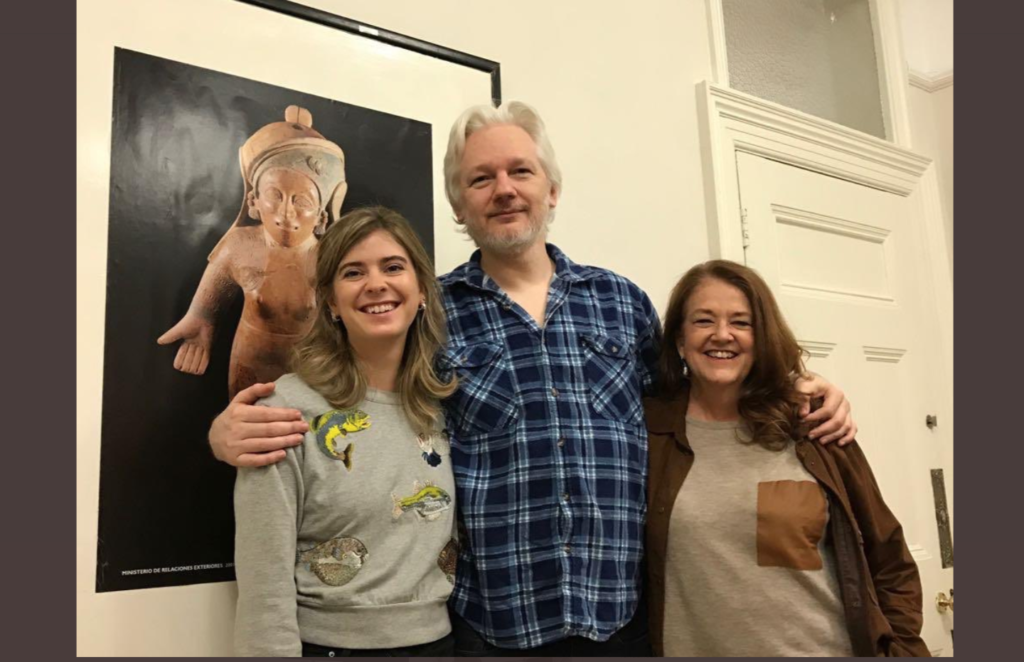
The hearing resumes as soon as Julian Assange returns, carrying the binder and a notebook in which he will try to write his little words. His face takes on an accusing look when he looks up at the first row of the audience. The prosecutor continues his charge: the thousands of leaked documents are detailed, Julian Assange is accused of having encouraged Manning to steal the documents by helping him to crack a password to access an army intranet. He wanted to undermine the security of the United States, especially since « Wikileaks » on its website « solicits the public to deliver secret documents. To support his claims and to bring a semblance of links between Julian Assange and « Wikileaks » the prosecutor cites the conference of the Chaos Computer Congress in Berlin in late December 2009, where Assange would have presented this project as « the intelligence service of the people ». The Wau Holland Sitftung curiously does not appear in the prosecutor’s tirade, even though it assumes full responsibility for the Wikileaks project in its own activity reports from 2006 to 2014, as if the British state wanted to spare a German institution, in the midst of negotiations with Germany over the Brexit. Manning would have responded to Julian Assange’s requests and would have downloaded the encrypted documents from February until his arrest on 27 May 2010. The link between Manning and Assange would be provided by their communication on the Jabber messenger from November 2009 to April 2010. I am surprised to hear about the relationship between Julian Assange and Chelsea Manning. I had been left with Julian Assange’s denials that he had ever been in contact with Private Manning and I had believed that Manning had dropped his information by talking to hacker Adrian Lamo[9] , who was mysteriously murdered in 2016 and that is how the military was able to find his identity. Jabber messaging was also a project of the Wau Holland Foundation since 2008[10] . It will be necessary for the prosecutor to provide technical evidence of the conversations on Jabber, records from Internet service providers, and not Manning’s confessions extracted after torture.
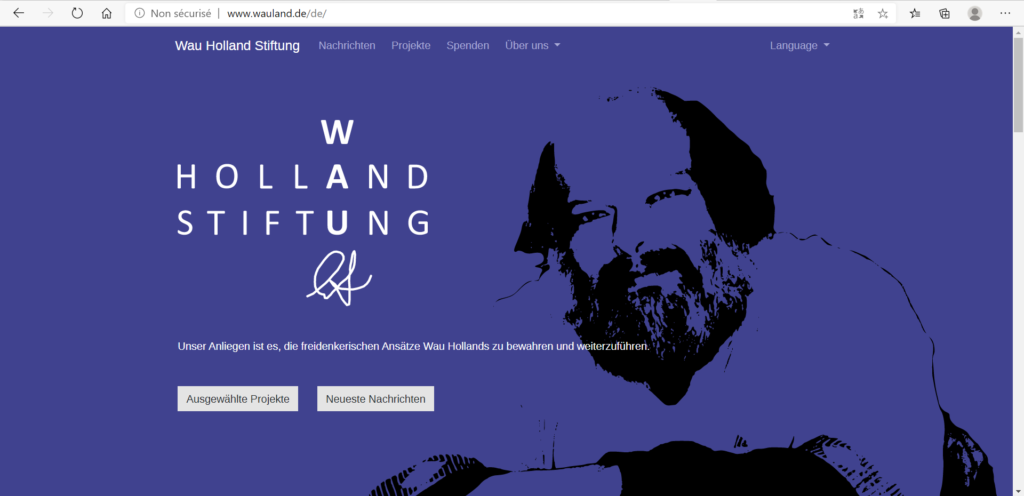
Despite the dramatic situation, John Shipton’s brother falls asleep in his seat. Julian Assange looks at Kristinn Hrafnsson with a resigned but angry expression. The RSF men leave. Garzon looks annoyed. Then the prosecutor moves on: the Taliban in Pakistan would have used the published documents to commit crimes, Julian Assange would have given « useful information to the enemy », he knew he was putting his sources in danger. This is very different from the first phase of the publications which targeted only the Chinese and the Syrians. In short, if Julian Assange knowingly gave information to the enemy, he can be accused of « intelligence with the enemy », thus of espionage. We hear the clamor of the Gilets Jaunes rising. Julian Assange surely hears it too… It’s loud.
He is fidgeting on his bench, looking for a position, writing something, can’t get rid of this tic that makes him blink and look for the light by raising his face upwards, towards us. Now the prosecutor will prove for an hour that the law on « conspiracy » is the same in Great Britain as in the United States, and already refute the arguments of the defense on the « abuse of authorities », i.e. the procedural flaws. Julian Assange seems to be doing better – he writes a short paper to Garzon. Baraitser was obliged to ask the prosecutor for the beginnings of evidence. He explains that if the newspapers helped to disseminate information to the enemy, then yes, they can also be charged. Clearly in « certain circumstances » the extradition treaty does allow for extradition on political grounds, anyone, British or otherwise.
Then I see Julian Assange raise his head and look at Angela Richter, sitting in the middle of the front row. He gestures to her with his hand, as if he wanted to chase someone away, indicating that he should leave. He clearly points to the door. I get the impression that Richter is embarrassed, she looks around to see if anyone else has figured out what is going on. The prosecutor says he doesn’t need to submit evidence, what he says is « self-sufficient », a curious category of law all the same. At this point Julian Assange looks very tired. He does not even have a glass of water in front of him, unlike the lawyers and journalists. He crosses and uncrosses his fingers, looks at the journalists… then he wants to speak! He stands up, holds his hands together in front of the glass and speaks. Baraitser wants to cut him off, telling him to speak through his lawyers. But he insists and wants to speak himself. We can’t hear what he says, because there is no microphone and we can only hear what is said directly into the microphones. Focusing on his voice muffled by the barriers, we think we hear him complaining about not hearing. And it is certainly not the decided slogans of the Yellow Vests that bother him, contrary to what Baraitser will argue. We do not let him continue to speak. A cardboard box is placed under Fitzgerald’s microphone to increase the volume… Finally, at 1pm Fitzgerald is allowed to start the defense. 20 minutes later Baraitser suspends the session for the lunch break. We are asked to leave the premises via the fire escape.
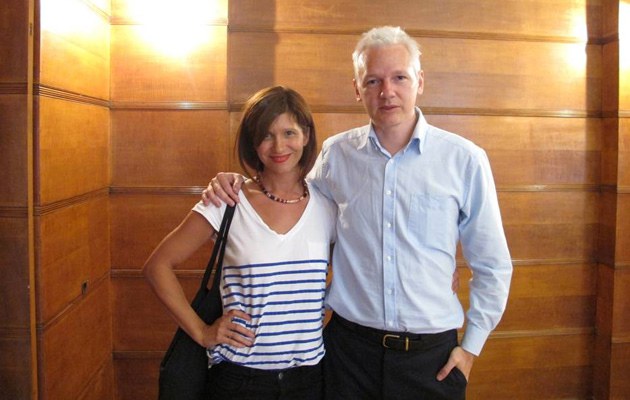
We only have 45 minutes, the cafeteria is tiny and the line is quickly huge. I am exhausted and I take a coffee at the vending machine before going back to the airlock. My friend who took the picture when Julian Assange spoke was immediately expelled from the building, she does not insist. I try to find out more about what Julian said by asking Fitzgerald in a corridor of the court. I can’t, he remains evasive. I hurry back to the airlock, because even if there are less people in the afternoon, it was predictable that some of them are more interested in their public relations than in the trial, Greekemmy is watching over them to introduce his own.
What exactly is Wikileaks? Plea of Me Hamilton Fitzgerald
I managed to get back into the gallery without too much damage after waiting in the airlock and going up the fire escape, despite my fear of being pressured again by those present to give up my seat to someone « high up ». The vacated seats were quickly filled: Sevim Dagdelen and Heike Hänsel were seated next to Angela Richter. The young free-rider’s boyfriend blinks from behind me. Julian Assange enters the box at 2 pm. He is as sad as ever, sitting with his hands clasped, not looking at the family, not smiling at anyone… Hamilton Fitzegerald resumes his speech: he wants to rely on Article 10 of the extradition treaty, to present the « abuse of procedures », procedural flaws and to prove « on the basis of the Castillo and Murua jurisprudence » (probably Adgar Castillo against Spain – judgment of the European Court of Human Rights in 1998) that Julian Assange had in his action political opinions, that he is therefore being prosecuted for these opinions and that therefore the extradition treaty would be violated if extradition were to apply to his case. Furthermore, his extradition would expose him to inhuman and degrading treatment, the risk of suicide, and the risk of the death penalty. Then the lawyer quotes the witnesses who will appear: academics and journalists specialized in espionage and computer data leaks, Jamil Jabber from Columbia University, Michael Tigar, American attorney and professor, and also the very famous Noam Chomsky. Then the lawyer recounts the story of the « Wikileaks » publications: he tells how Bradley Manning said he downloaded the documents himself, contacted the Washington Post, and then decided in February 2010 to give everything to the « Wikileaks » website, including the film of the « air attack on innocent civilians in Iraq » and, on March 8, 2010, the documents relating to the Guantanamo Bay prison, guided by the idea that it was « in the public interest » to publish them. Passing quickly over the fact that it was the Obama administration that initiated the hostilities against Julian Assange, the lawyer charges President Trump by recalling his violent tirades against the journalistic profession. Gareth Peirce then goes to Julian Assange and hands him a document. He gets up with difficulty to take it, sits down and stares in front of him without moving.
Edward Hamilton then paints with a few flattering phrases the « Wikileaks saga » that lasted a few months, a year maximum in 2010 and 2011. In his mouth Julian Assange is mixed with « Wikileaks » without it being clear who decides what. He even credits the site as « catalyst of the Arab revolutions by exposing the corruption of the Ben Ali clan in Tunisia » which makes me smile a little. Through friends of UGET, Redeyef, the Patriotic Democratic Party that I supported in 2011, I know that Tunisians did not need Westerners to realize the violence and corruption of the dictatorship in which they lived. I also know that the real Revolution of December 2010 started from demonstrations launched by activists of the UGET, one of the oldest trade union organizations in Africa, just as the « Kasbah 1 » movement in February 2011 was initiated by two young girls desperate for repression, Zahra and Hawra Khammassi, Zahra being in charge of the UGET union at the Faculty of April 9. I hope one day to be able to get Julian Assange to meet the real protagonists of this story, but for that to happen, he has to get out of this jail. While the lawyer continues to explain the case, I finally see that Julian Assange looks at me firmly, I immediately respond by supporting his gaze. Then he looks more tired and the self-centered and repetitive gestures reappear: he rubs his fingers and again raises his head towards the ceiling as if he had a backache. But then I see even more clearly the look in his eyes that says he is suffering.
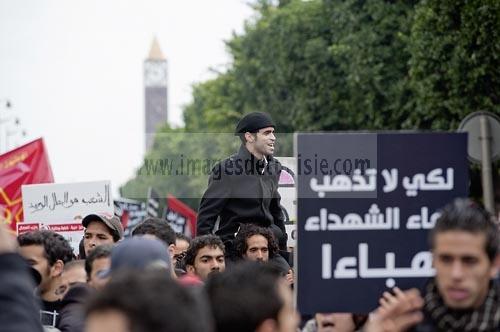
Fitzgerald then makes the trial of the company UnderCover Global, of the spying that it exercised on lawyers like Gareth Peirce, who will also be a witness, how it « poisoned » the relations in the premises of 3 Hans Crescent Street by abusing the good faith of Fidel Narvaez, head of security of the Ecuadorian diplomacy. It is in this context that Fitzgerald places the story he tells: that of Dana Rohrabacher, a senator close to Trump who came in 2016 to promise Julian Assange to let him out of his captivity in exchange for information allegedly given by the Russians. Fitzgerald again condemns the Trump administration as practicing political blackmail, seeking to extort benefits on the back of his client. I think the political narrative is getting a bit off track: for my part I would have liked to know more about the motivations of the Wau Holland Stiftung when it decided in December 2006 to « fördern », i.e. both support and execute, the 04 Wikileaks project[11].
As for Germany, journalists from Spiegel will play an important role as defense witnesses – Fitzgerald cites John Goetz and even Jacob Augstein, the son of Rudolf Augstein, the magazine’s founder, as witnesses who have always claimed that Julian Assange protected his sources and was never involved in hacking classified documents. Unfortunately, while the lawyer portrays a politically committed man, a champion of transparency and anti-imperialist struggle, the flattering praise has no effect on the morale of Julian Assange who seems immobile, locked in his suffering. I too am beginning to feel bad about witnessing his suffering, and it is not Fitzgerald’s words quoting a Chomsky charge about Trump that will give me confidence, as Obama is largely responsible for the « Julian Assange manhunt » as well. Finally, the lawyer addresses the hardest but most obvious: extradition will lead Julian Assange to undergo « degrading and inhumane treatment », the risk of a life sentence is evoked, and the conditions of imprisonment in the United States detailed. Finally, Fitzgerald exposes that his client’s living conditions, the fact of « being exposed with his family as a target », of being « exposed to isolation » has led his client, according to two doctors quoted, Dr. Crosby and Prof. Malon, to a « clinical depression ». Extradition will worsen his « fragile state of health » and lead him to suicide.
The curtain falls. Baraitser adjourns. Julian Assange raises his fist but looks exhausted. I refuse to leave our box until he leaves his. I observe his walk, his gestures, I observe the guards. Nevertheless, I could meet his eyes one last time. When I leave the building, a hundred journalists, some kneeling, are religiously listening to John Shipton. I recognize and greet some of my Yellow Vest friends. It is necessary to debrief and rest, to understand what is happening. Tomorrow I will come back.
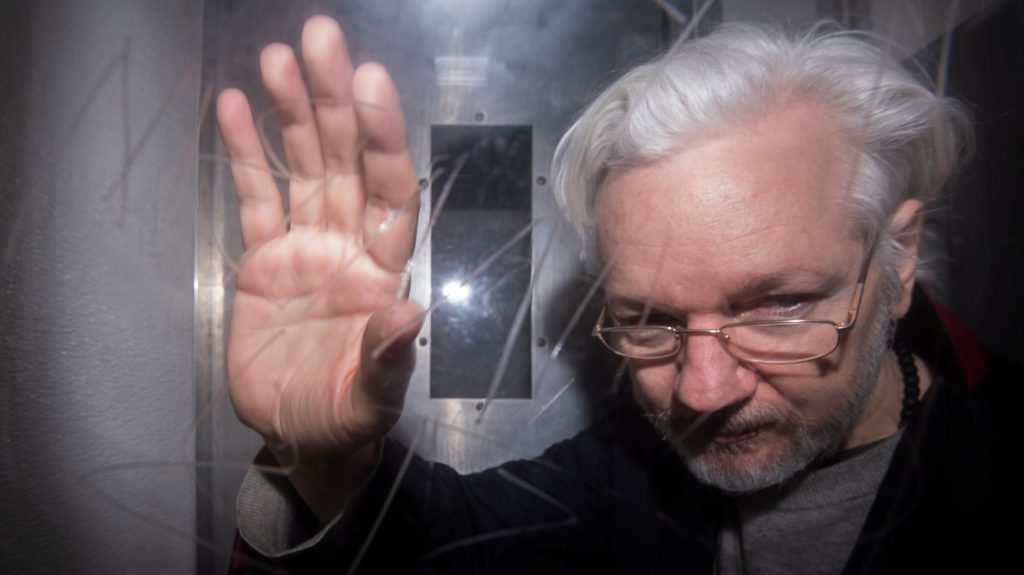
[1] https://courttribunalfinder.service.gov.uk/courts/belmarsh-magistrates-court
[2] https://www.thelawpages.com/magistrates-county-crown-court/Belmarsh-Magistrates-Court-106.html
[3] https://searchapplications.bromley.gov.uk/online-applications/propertyDetails.do?activeTab=summary&keyVal=L5YN3SBT06500
[5] https://appext20.dos.ny.gov/corp_public/CORPSEARCH.ENTITY_INFORMATION?p_token=72B2BC88F1ABEC29FC17342ED048F90C2CD3180F91B4ABC04CC549D1FF9DBC78DEDF372F0216B3421318E1E20D7C94DF&p_nameid=783838A9DC6C9F54&p_corpid=0DFAEC3F1D70B519&p_captcha=14488&p_captcha_check=72B2BC88F1ABEC29FC17342ED048F90C2CD3180F91B4ABC04CC549D1FF9DBC78250B421436A200E165E9DFBDDBEDCDA1&p_entity_name=%43%6F%75%72%61%67%65%20%43%6F%72%70&p_name_type=%41&p_search_type=%43%4F%4E%54%41%49%4E%53&p_srch_results_page=0
6.
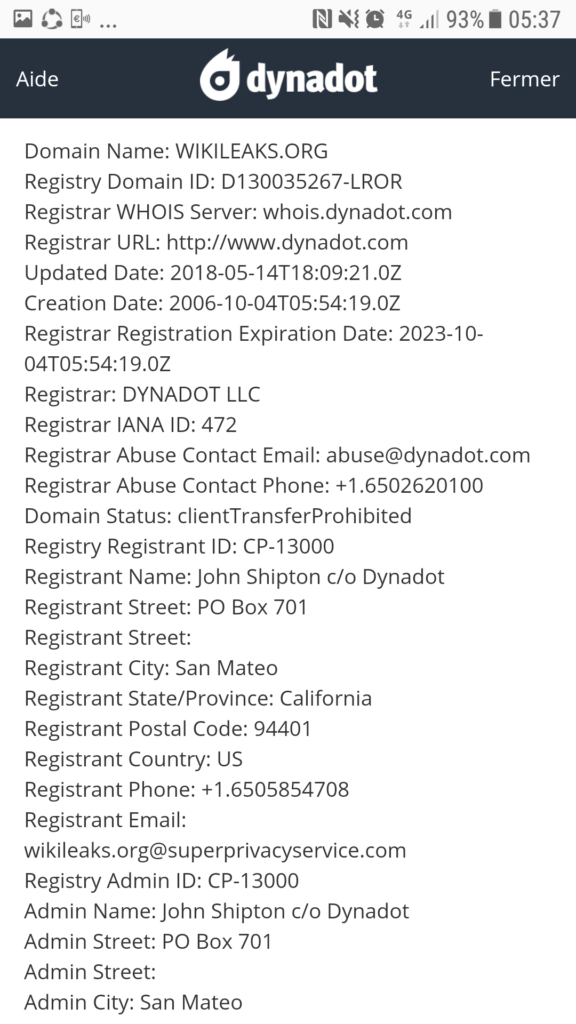
[7] http://www.wauland.de/media/2011_Jahresbericht.pdf, report 2011
[8] http://www.wauland.de/media/2011_Jahresbericht.pdf, page 5
[9] https://www.pbs.org/wgbh/pages/frontline/wikileaks/interviews/adrian-lamo.html
[10] http://www.wauland.de/media/2009_Jahresbericht.pdf
[11] http://www.wauland.de/media/2009-12-28_Protokoll.pdf, Report of the Board of Administration of the Wau Holland, 28 december 2009